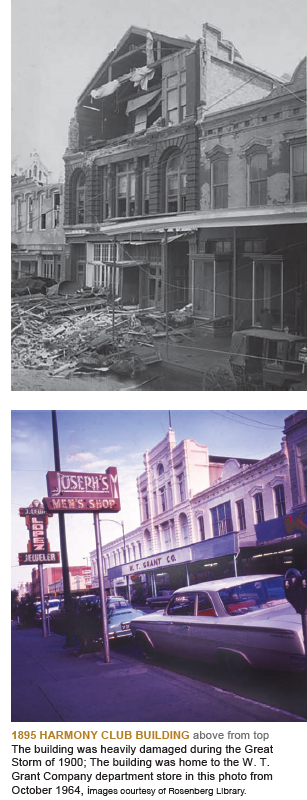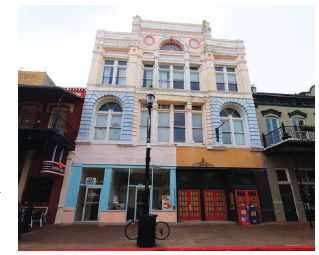The fact that the Harmony Club Building is one of the most attractive business structures on Postoffice Street should not come as any surprise. It was designed by Nicholas Clayton, one of the island’s preeminent architects, for an elite Jewish social club.
The Harmony Club was organized in 1870 and chartered on January 24, 1889, with 100 original members. The club once occupied Clayton’s 1883 Harmony Hall one block away on Church Street, but the opulent property became too expensive to maintain. That building was later occupied by the Scottish Rite.
The new $17,000, three-story structure built on Postoffice Street was financed by Joseph Levy and his brother Bernard who owned the lucrative Levy & Brother livery stables, undertaking establishment, and carriage business on Church Street.
The 1895 Harmony Club Building featured a striking, raised central frontispiece, arched windows, brick walls, wood floors, seven brick fireplaces, and two bathrooms. The upper floors were used for club meetings and special events and their walls were plastered and wainscoted.
The second floor originally boasted a bowling alley for the amusement of members. A full staff, including a porter, steward, and two janitors, were employed by the organization.
 The ground floor was designated as a rental space to provide funds for the upkeep of the building. Additional income was raised by renting the upper event spaces to other island organizations.
The ground floor was designated as a rental space to provide funds for the upkeep of the building. Additional income was raised by renting the upper event spaces to other island organizations.
Businesses immediately leased the first-floor store areas and profited from the downtown location. Two examples of businesses were Galveston Engineering and Electric Company owned by Carl P. Young and Abraham Cohen, and the Galveston Art Supply Store owned by August Tacquard and Albert F. Heckell. Both of those companies were located in the Harmony Club Building when the devastating 1900 Storm struck Galveston.
On July 31, 1900, 23-year-old Sylvain M. Blum, a stenographer and private secretary to Waters Davis, Jr., shot and killed himself upstairs in the building. The reason for his suicide was never revealed.
Adding to the tragedy, his young widow Jennie Mazur Blum, her in-laws, and several other family members perished in the hurricane just a few weeks later.
The front portion of the top floor of the Harmony Club Building was heavily damaged and windows were blown out of the structure during the Great Storm. However, the ground floor retail space was open for business within a few weeks of the clean-up process.
The electric company remained at that site and was joined by Alfred Stanley’s No Co. glass, wallpaper, paint, and window shade store.
After the storm, Stanley’s business was the only one on the island that had an ample supply of plate glass and the skilled labor to install it; both of which were in high demand. One of the largest jobs they were awarded was the task of replacing the shattered windows in the now-demolished Union Railway passenger station. He and his workers also traveled to surrounding communities to work after the hurricane.
Stanley’s store remained in the Harmony Club Building until 1915.
From 1905 to 1915, German immigrant Richard Johnson operated the Enterprise Coffee and Tea store at this location. He installed an electric motor grinding machine and gas-powered coffee roasting equipment that was considered state-of-the-art at the time. Their close proximity to the port meant access to the freshest coffee bean shipments.
Other businesses came and went as fortunes changed or other opportunities presented themselves.
For a short time around 1914, Miss Florence Settle operated a private dance studio and school on one of the upper floors, as the space was not usually in use by the club during the day.
John and George P. Stathakos manufactured and sold candy at their Royal Candy shop at this address, and a relative operated another candy shop on Market Street. Their candy maker, Louis Spernakos, lived in an apartment upstairs.
At other times, Buford W. Mayberry managed a Singer sewing machine store there, and W. Wilson and William J. Shaw operated Wilson & Shaw furniture. The building also housed the Newark Shoe Store in the late 1920s, a beauty parlor, a photography studio, a dress shop, an optometrist, and a jewelry store.
The Harmony Club continued to hold its events on the upper floors until the El Mina Shriners purchased the building in the 1920s.
 In 1941, the W. T. Grant Company national department store chain purchased the building as its Galveston location for a “one cent to one dollar” discount store. Though former tenants had carried out remodifications on the building before, including installing an awning and reconfiguring walls, the Grant Company far exceeded these minor changes.
In 1941, the W. T. Grant Company national department store chain purchased the building as its Galveston location for a “one cent to one dollar” discount store. Though former tenants had carried out remodifications on the building before, including installing an awning and reconfiguring walls, the Grant Company far exceeded these minor changes.
That fall, they spent $39,000 installing a sprinkler system. In addition, they opened walls on the first and second floors to create access between this building and its next-door neighbor at 2113-2115 Postoffice, creating a larger store space.
The El Mina Shrine Temple still operated out of the top floor, where locals would stop by to purchase tickets when the annual Shriner’s circus was in town.
The W. T. Grant Company went out of business in 1976, and Mrs. Mary Rodriguez purchased the property in 1977. By this time, it was discovered that the electric wiring in the former club rooms did not meet safety standards, the circuits were overloaded, and the wires at the outlets weren’t properly protected.
Those issues along with structural updates have been solved by more recent owners, and the building now provides six loft apartments and retail space in a coveted location in town. It carries on the traditions of appreciating beautiful architecture and providing residential opportunities close to popular downtown shopping and activities.
The Levy Brothers would be proud.